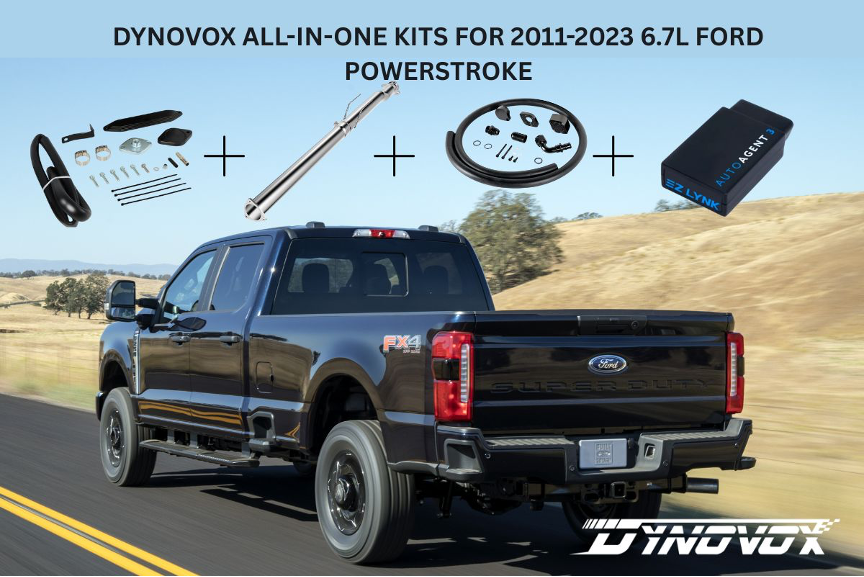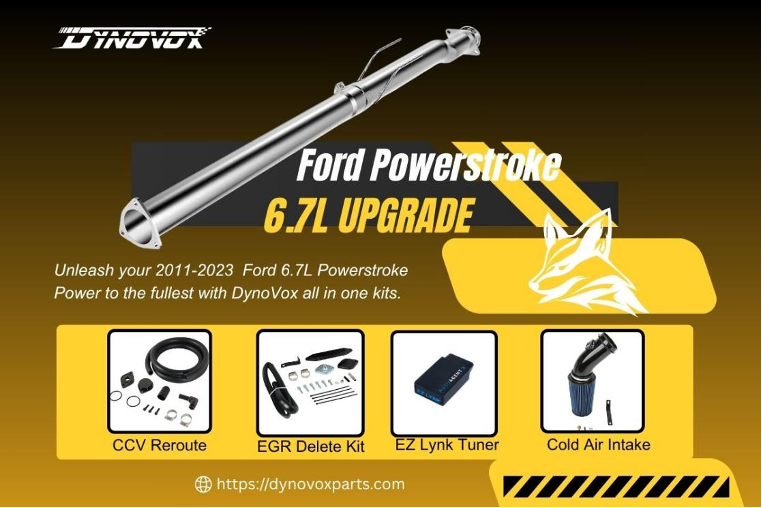The Diesel Particulate Filter (DPF) is a critical emissions control component in modern 6.7L Powerstroke engines, specifically those produced from 2011 to 2023. While its primary purpose is to reduce soot emissions by trapping particulate matter from diesel exhaust, the DPF significantly hampers fuel efficiency. This is due to its restrictive design, which creates backpressure in the exhaust system, forcing the engine to expend additional energy to push exhaust gases out. Moreover, the DPF system initiates regeneration cycles, a process in which raw diesel is injected into the exhaust to burn off accumulated soot at extremely high temperatures, often exceeding 1,000°F. During these cycles, fuel is consumed without generating any propulsion, effectively wasting between 5% to 15% of diesel fuel in stock configurations.
As a result, many Powerstroke owners seeking better fuel economy consider deleting the DPF. But how much real-world fuel savings can you expect?
The Mechanics Behind MPG Improvement
Deleting the DPF removes one of the most restrictive elements in the exhaust system. This modification targets two primary sources of fuel inefficiency:
1. Reduced Exhaust Backpressure
Without the DPF, exhaust gases flow more freely, reducing strain on the turbocharger and improving overall engine breathing. This enhanced flow improves combustion efficiency and throttle response, allowing the engine to operate more effectively.
2. Elimination of Regeneration Cycles
By removing the DPF, the engine no longer performs active regenerations, which involve injecting additional fuel into the exhaust stream to incinerate trapped soot. Eliminating this process preserves diesel fuel for actual propulsion, not wasteful emissions control.
However, it’s essential to understand that these gains are not automatic. The engine’s control module (ECU) must be professionally retuned to optimize fuel maps, injection timing, turbo vane actuation, and other parameters. Without proper tuning, the engine may operate inefficiently or even suffer from reduced performance and fuel economy.
Quantifying Real-World MPG Gains
Based on fleet studies, tuning shop data, and owner reports, deleting the DPF and applying quality tuning can produce substantial improvements in miles per gallon (MPG). The extent of improvement depends on how the vehicle is driven.
| Driving Condition | Stock MPG (Avg.) | Post-Delete MPG (Avg.) | Estimated Gain | Improvement (%) |
| Combined (City/Highway) | 14–18 MPG | 16–22 MPG | +2–4 MPG | 12–22% |
| Highway (Unloaded) | 16–20 MPG | 19–25 MPG | +3–5 MPG | 18–25% |
| Heavy Towing | 8–10 MPG | 11–14 MPG | +3–4 MPG | 30–40% |
Highlights:
Towing Efficiency: The greatest MPG improvements are seen when hauling heavy loads. One verified study across a fleet of deleted 6.7L Powerstroke trucks reported a 12.5% average MPG increase during towing cycles.
Highway Driving: Long-distance, steady-speed driving typically yields the best fuel economy benefits—some owners report up to 25% improvements when cruising without cargo.
These gains assume the use of quality parts, professional installation, and driving habits optimized for fuel efficiency.
Key Factors That Influence Your Actual MPG Gains
Not all DPF delete results are the same. The following elements can significantly impact your final fuel economy:
1. Tuning Quality
Custom ECU tuning is absolutely essential. Generic, one-size-fits-all tunes often fail to extract the full fuel-saving potential from a DPF delete. By contrast, custom tunes can be tailored to your truck’s specific setup—including gear ratios, tire size, elevation, and use case (e.g., towing vs. commuting). DynoVox’s integrated delete kits come with precision tuning files designed to optimize both performance and efficiency, ensuring safe combustion and smooth engine operation.

2. Supporting Modifications
While not strictly required, the following upgrades can amplify fuel economy gains:
High-Flow Exhaust Systems: These systems further reduce backpressure, enhancing the fuel economy benefits of DPF removal by allowing exhaust gases to exit the system more efficiently.
Cold Air Intakes: Improved engine breathing is critical under load. By providing cooler, denser air, especially during towing or hill climbs, cold air intake systems can improve combustion quality and efficiency.
Thermostat Upgrades: Maintaining optimal engine temperature is essential for efficient combustion. A performance thermostat helps the engine reach and sustain ideal operating conditions faster, especially in cold climates.
EGR Delete Kit: Exhaust gas recirculation (EGR) contributes to carbon buildup and intake restriction, which can compromise fuel efficiency over time. Installing a high-quality EGR delete kit can reduce soot accumulation, lower intake temperatures, and improve combustion efficiency. We recommend the DynoVox EGR Delete Kit for 2011–2023 Ford 6.7L Powerstroke Diesel for Powerstroke owners seeking better fuel economy and long-term reliability.
3. Driving Style and Conditions
Aggressive driving—such as rapid acceleration, excessive idling, and driving over 70 mph—can reduce the MPG benefits of a delete. Additionally, large off-road tires, vehicle weight, and terrain type also influence results. Owners of lifted trucks or those with oversized tires may experience lower-than-average MPG gains.
Legal and Reliability Considerations
While deleting the DPF can significantly enhance engine performance and fuel efficiency, it is crucial to understand the associated legal and mechanical implications.
Legal Status:
In the United States and Canada, removing or disabling emissions equipment such as the Diesel Particulate Filter (DPF) is prohibited for on-road use under the Clean Air Act and equivalent environmental regulations. Violations may result in substantial fines, emissions test failures, and the voiding of manufacturer warranties. In stricter jurisdictions—such as California, New York, Ontario, and British Columbia—vehicles may even be impounded. However, exemptions may apply for vehicles designated solely for off-road, agricultural, or motorsport use. Vehicle owners should verify applicable regional laws before undertaking any emissions-related modifications.
Reliability Impacts:
When professionally installed and tuned, a DPF delete can improve engine reliability by eliminating the heat stress caused by regeneration cycles and preventing soot buildup in the intake system. These benefits reduce wear on components such as the turbocharger and EGR system. However, improper installation or substandard tuning can lead to serious issues, including turbo failure, inefficient combustion, and persistent diagnostic trouble codes. To mitigate these risks, DynoVox delete kits are designed with CNC-machined precision parts and optimized tuning files to ensure safe, reliable operation under varying load conditions.

How to Maximize MPG Safely and Responsibly
For owners in regions where DPF deletion is allowed for off-road or non-road applications, following best practices is essential to ensure both efficiency gains and mechanical integrity:
Verify Compliance: Always confirm local and federal emissions regulations before proceeding with any modification. Some jurisdictions allow exemptions for non-road, agricultural, or historic vehicles.
Use Professional Tuning: Rely exclusively on high-quality, professionally calibrated ECU tuning to ensure proper fuel mapping, air-fuel ratios, and turbo control. DynoVox provides tailored solutions specifically for the 6.7L Powerstroke, minimizing risk while maximizing results.
Practice Fuel-Efficient Driving: Avoid excessive idling and aggressive acceleration. Maintain consistent highway speeds and use cruise control where applicable. Proper tire inflation and reduced payload also contribute to improved MPG.
Maintain the Vehicle Regularly: To sustain post-delete performance, clean or replace fuel injectors annually, change air filters every 15,000 miles, and update tuning files whenever hardware configurations change.
Final Thoughts: Tangible Gains, Measurable Risks
Deleting the DPF on a 6.7L Powerstroke can lead to substantial fuel efficiency improvements—typically 2 to 5 MPG in combined driving conditions and up to 6 MPG or more on the highway. Gains are especially noticeable when towing, where reductions in backpressure and the elimination of regeneration cycles provide meaningful diesel savings. For high-mileage drivers, these improvements can translate into thousands of dollars saved annually.
However, success hinges on the use of high-quality components, expert tuning, and full awareness of legal constraints. DynoVox’s engineered delete kits provide a trusted pathway to unlocking performance and fuel economy—especially for off-road or non-road applications. That said, responsible performance upgrades always start with knowledge and compliance.
Always consult a qualified diesel technician and review your local regulations before modifying any emissions system.
Lynn Martelli is an editor at Readability. She received her MFA in Creative Writing from Antioch University and has worked as an editor for over 10 years. Lynn has edited a wide variety of books, including fiction, non-fiction, memoirs, and more. In her free time, Lynn enjoys reading, writing, and spending time with her family and friends.















